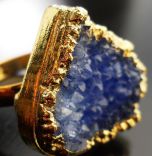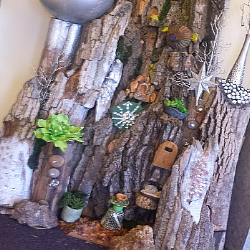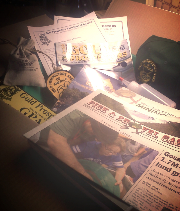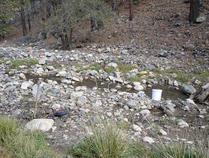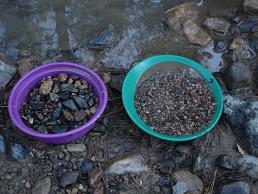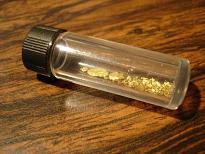
Finding a Way
Last year prospectors were wondering if they would even have access to their claim on the Blackfoot River.
With multiple talks with the Governor's men, Senator Daines's staff, national mining magazine reps, and national mining crisis consultants, the pressure must have worked because voila:
The culvert in question was demolished accidentally by the USFS truck with too big a load, the USFS put in a new spout for the bull trout to reign supreme, and plans for a side railing for equipment to cross the creek are in motion.
Imagine that: the bull trout and the prospector CAN REIGN SUPREME, and the USFS can cooperate not dictate!! With pressure, they can be problem solvers. It took change in their offices, and a woman in charge to make it happen. But it did!! The prospector is respected for once on Stemple Pass. Amazing!!
The Beginnings of Life in a Stone
Scientists researching stones in Australia recently discovered how life began on this planet by dating the life in the stromatolites found there.
Now, this same stone can be found in the Trex Agate Shop and the owner, John, says, "We owe our life to this stone." There once was just methane and carbon dioxide on this planet but this stone allowed for oxygen to be formed on the planet making an opening for the development of human life as we know it.
Just recently this knowledge was supported by researchers studying rocks there that look just like this picture.
Check out this link and listen to what you might find out in their studies. It is interesting. https://www.msn.com/en-us/video/science/scientists-have-found-the-earliest-evidence-of-life-on-earth/vi-AAHTsuD
Salting Your Rocks
Some rock shops take to adding some spice to your purchases.
What's salting you ask. It's adding stones of a variety of types to your bag so you can feel like your investment wasn't in vain. It is really the attempt of the company to make you as the customer happy.
But one drawback of this, is some of the stones that are added are so similar to sapphires that one can mistake the fake stone for the real one.
When you have your bag that you think are sapphires so full of strange stones you have no idea of what they are, you wonder what kind of mish mash you are purchasing. You think you are getting a garnet or sapphire bag, but you might get all kinds of things. These are cheaper stones that are a distraction and the process of salting might not always be a good thing. All those shark teeth are not what you are going for. Just saying.
The Features of Rocks Can Help Humans Build, Repair, and Grow
The shiva lingam stone can be found in a variety of rock shops throughout the state of Montana. Rockin' Rudy's in Missoula and the Trex Agate Shop sells them too. Just what is the attraction of this stone found in India? I wanted to know so here is what it says about the reason for the curiosity and need to have one: The Shiva Lingam represents harmony and balance and facilitates the union of opposites, such as masculine and feminine or body and soul. It is excellent for sexual healing. This stone facilitates releasing all that you have outgrown. It is particularly useful for emotional pain that arises from early childhood, especially from sexual abuse. It can draw a sexual-healing partner to you. There are many more points to be made about this stone which can be found on this website: https://www.naturalmagnetism.com/shiva-lingam-stone.html
Different Rocks From Different Spots
Even though you can go chase those agates up the hillside out of White Earth, when you come across an unusual looking one at a Gem and Mineral Show, you pick it up so you can take it home with you. Oregon is home for a polk-a-dot rock when cut does not look anything like Montana agates that are clear and see through. But the beauty is there and the designs are what make perfect jewelry.
This piece shown here was part of a collection bought from an estate and was sold as is. Many rocks are found this way as they transition from one person to the next. The unusual is what is attractive as it shows how clever the earth is in manufacturing the world's greatest attractions. Check out the variety in life to keep things interesting.
The Influence of Bedrock in Searching for Gold
Vocabulary Beef Up:
Just what is a druzy? Never heard the word until crystal hunting with Andrew Luna in the Elliston hills. When we pulled out a stone from the clay formation of a mini cave he
said,
"That's a druzy!" Sounded like he said, Doozie. Nope. Had to look it up and sure enough all kinds of people know what they are because they sell jewelry made out of them.
It's when rocks are formed in a conglomerate of formations on top of each other in odd formations of one. They are just spectacular and you can make your own as well. DRUZIES art the things to have. I know I wanna make a piece of jewelry out of what I found. Guess I will keep Meg Magnuson busy making jewelry out of my finds. She's the metal smither at the Columbus Center in Great Falls.
Educate Yourself About Mining Towns of Long Ago with the Butte Museum
Education Starts With Knowing Your Rights to Public Access and Using Your Voice
One of the things you need to educate yourself about in regards to prospecting is the fact that public access to your claim or the closing of roads has a huge impact upon the indivdual or club. Letting your voice be heard is crucial in making change. One can speak with local reps,. but if that doesn't work out, the state level might help. Our group has gone to the national level for help too.
But the key thing is the influence of the USFS upon the state level. When this government agency has too much power over the citizens of a state, who is to intervene? I think our state government should work for its citizens. The governor's email is right on line and this is what he got sent to him about the power struggle over public access. I met with Patrick Holmes and Ryan Weiss with other members of the Blackfoot Prospecting Club of Lincoln May 7th about our lack of access to our claim because of the continuing harassment by the USFS. In the years of processing with the USFS we have heard, "We don't need the culvert for ground crews to access fire suppression in the area, we use helicopters now." Hmm... the fires in Lincoln last year had many ground crews fighting the fires. How can the USFS be continually closing roads cutting off access to thousands of acres of forest service land and for the public when we need these roads for the protection of the public lands? There is something significantly wrong with this picture and certainly your Policy Adviser, Patrick Holmes should be on top of this, getting back to us and hopefully turning this picture around.
An interesting video of a healthy way of gold extraction.
Learning More About How the Department of Environmental Quality Fails the Public
It was with donations to the Montana Enviornmental Information Agency that took the Montana State Department of Environmetal Quality to court to protect Montana waters because they were going to allow Hecla Mining Company to pollute extensively the waters of Montana by allowing the proposed company to pollute multiple rivers and streams with contaminants.
A Montana District Court judge has just invalidated the water pollution permit for the Montanore Mine, a proposed silver-copper mine that would have bored beneath the Cabinet Mountains Wilderness in Montana.
The permit issued by Montana’s Department of Environmental Quality would have allowed Hecla Mining Company and its subsidiary, Montanore Minerals Corporation, to discharge mine wastewater and contaminated storm water into multiple streams that traverse public lands in the Cabinet Mountains and provide irreplaceable habitat for threatened bull trout.
|
Prospecting Goes Artistic
As the years march on, so does the mind’s creations of advertising prospecting. In 2017 the Great Falls Public Library was full of rock sculptures, rock photos, clue questions in the Kid’s Place for searching the life of prospecting in Montana, jewelry examples with rocks, wall art, and community art all made with the love of rocks at heart. Prospecting is inherent in psyche of Montana people of all ages.
These two top photos are from 2016 art in prospecting in Great Falls. May expressionism with prospecting continue to grow exponentially in Montana.
Sign Up For Classes With The Master!
Want to learn how to set your stones into a specialized designed piece of jewelry? Contact Meg Magnuson as she has a degree in metal smithing from MSU Bozeman and spent months on fabricating and constructing belts, headdressess, you name it for the creative imagination.
Meg teaches classes at the Four West Art League in the Columbus Center and has her own studio.
Group classes or individual instruction can be arranged by calling 406 231-8898. You will be on your way to individualized creations in metal with stones.
Rock Identification Class Dishes On a Wide Range Of Earth's Gems
Hover mouse over picture to see descriptions.
A Concise Description of How to Pan For Sapphires, The Montana State Stone, That Can be Found All Over The State! Print Yourself Up a Copy.
Rock Hounding vs Gold Prospecting
Interest and motivation swirls around the world of the recreational prospector. Some folks like to rockhound, others like to pan for gold in the streams and riverbeds. Each person has unique information to add to your world if you ask.
Josh Saksa of Helena is an avid rock hound and geological student who hikes the mountain tops of Montana in pursuit of the mineral beauties they have to offer. In discussion with him many pointers were given that were of ultimate value.
One of the most important pieces of information was the suggestion of going to the Montana Bureau of Mines and Geology on the campus of Montana Tech. He said their archival area has a wealth of information that they will put on a disk for you. The key piece he shared was that long ago when the records were divided up in Montana, half of our history went to Idaho. It would benefit anyone wanting to do research about history and minerals in Montana to look into both of these sites for information.
That is why 2017 kicks off with a day of research at this facility to see what can be gathered and brought home for research. Apparently this Bureau has some of the only records available anywhere. We’re on it! Going to investigate and see what we can find. But only a true rock hound would have given out this information. We thank him!
When this information was shared with the prospectors in the state, many said about pointers this rock hound suggested, “I didn’t know that!” So when you want to know about Montana minerals information from the gold prospector and the rock hound need to be combined for recreational prospecting leads and ideas. It’s good to combine the benefits of both worlds.
A "Teach Yourself "Prospecting Guide
A Prospecting Family Tradition
In the summer of 2015 while doing an article for a prospecting newsletter I brought over to the fudge family a bucket some classifiers and a tub for washing.
On 2nd Ave North in the back yard I taught the four Fudge kids how to prospect. It was great fun; I wrote up the article and when I stopped by a month later little Ellie ran down her wooden sidewalk on her scooter shouting, "Nathanial is going to grow up to be a prospector!"
In June, 2016 the fudge family went and prospected the entire day at the Blue Jewell Mine for the entire day. They dug gravel and classified to find no sapphires. The family is still interested in prospecting.
When I was at the Farmers' Market the Fudge kids came up to see what I had for them to prospect with. I gave them a Kid's Kit. The family took it home; Amanda Fudge added her own pie plates and extra marbles to the mix so that this summer July day the kids could prospect in their backyard.
When I got a text that they were in the middle of this i just had to stop by and cheer knowing that my teaching the love of prospecting is being carried on within their family. Prospecting is an integral part of their family now. Sweet.
There are a variety of ways to learn about recreational prospecting.
Sites
Besides the use of the internet for searching, one can also contact local prospecting groups such as Yellowstone Prospectors or The Blackfoot River Chapter to find more information from local people.
Another good opportunity to connect up with other prospectors is to go to your local Farmer's Market. Often times there are prospectors willing to show you how to pan for sapphires and or gold.
These booths are community base and offer this educational aspect for the general public to learn more.
It is a great way to make casual contact and get connected with others who are active in the field of recreational prospecting.
Classes
During the academic school year the Creative Center of 4West has classes in gold panning with Bob Rosteck, sifting for sapphires with Paxton Tutor, and recreational prospecting equipment with Delbert Henry and friends.
Each class is designed to get the student practiced in the basic differences and techniques between panning for gold and extracting sapphires from gravel.
In the future we hope to provide educational opportunity with mineral extractions with 406 Minerals.
This fall the center will kick off its season with fossil digging sessions with trained archaeologists teaching us about key elements in identification and discovery.
Hands On
In your area there are many people who have varying skills with prospecting equipment such as Delbert Henry at the Missouri River Diner. He has prospected all over Alaska and is willing to share his cube, trommel, and his homemade contraptions.
We hope to schedule once a month opportunities to process gravel at a site close by. If we arrange these demonstrations and equipment availability one can get their concentrates processed locally without investing in heavy equipment yourself.
Sharing our equipment can be the best thing for the development of recreational prospecting locally. Finding someone like this in your area is key.
GPAA
Important to note that there is a national organization called the Gold Prospectors Association of America (GPAA) that is a giant resource for gold prospecting information in the nation.
With membership it provides you with a mining guide, magazine, newspaper, videos, and supplies for you to use in recreational prospecting.
The best thing is the opportunity to prospect in 5 claims they own in Montana and it gives you GPS information as well as site specific details.
The Central Montana Prospectors have initiated outings for all five of the claims from this mining guide for anyone who would like to join in checking them out.
How To Pan For Gold
In order to pan for gold you need some equipment. This photo shows about the bare minimum of equipment you need to be a successful gold panner. Start with the water-proof boots and some warm socks. Gold panning is done in the water, usually icy cold mountain streams. You'll want to keep your feet dry. The green thing is the gold pan. There are lots of different types of gold pans. They all work. Inside the gold pan is the sniffer bottle. It is used for sucking up little bits of gold out of your pan. The purple thing is a classifier, also known as a sieve or strainer. Next, you need some digging tools: a full-size pointed shovel. You will also want a smaller spade and either an old screwdriver or some other skinny tool for cleaning out small cracks and crevasses in the rocks. A small white plastic pail is used for collecting concentrates. Big five gallon buckets also come in handy for lots of things. You can pack equipment in them down a creek bed, use it as a stool or carry your paydirt from where you are digging to where you are panning it. Tweezers are important to pick essentials out of your pan as well as a small bottle to put them in. Gloves are important to consider.
Next : find a stream to pan in. You'll want to pick one that has a history of producing placer gold. You can strike out on your own and prospect streams that haven't been mined
in the past, but odds are you won't find any undiscovered gold deposits. At one time or another, every stream, river, creek, and beach in North America has been test panned by prospectors. So odds
are, you won't find anything new. Going where gold has been found in the past is your best bet. Besides, over time, more gold weathers out of the bedrock and gets carried down into the same creeks
and streams that have been mined in the past. Every
rainstorm deposits more gold in the stream beds. Don't worry that all the gold has been mined
out.
Tips: If the stream isn't on public land, get permission from the owner first, or move on. Nobody likes trespassers. If the stream is on public land, make sure there isn't an active
mining claim in the area where you want to do your panning. Also check with the agency that manages the land the stream is on. They may have restrictions on what sorts of activities are allowed
there. If it is a designated wilderness area, then you probably aren't allowed to do any prospecting there. Even if prospecting and recreational mining activities are allowed on the land, there may
be restrictions on where you can do it and what sort of equipment is allowed.
Find a place to pan and places to
dig. They almost certainly won't be terriblyclose to each other. A good place to pan is an area of the stream
where the water is deep enough to completely submerge your pan, and has enough water flow to keep the water clear so you can see what you are doing. If the current is too strong though, you will find
it difficult to work the pan.
Where to dig? Gold is heavy. It is a lot heavier than most of the other rocks and minerals in the stream. It takes a lot of force from the moving water to keep
gold suspended in the water and move it along the stream bed. So anywhere the water slows down is where the heaviest stuff suspended in the water is most likely to settle out. The inside of bends is
one place. Water flowing down a stream moves slower on the inside of a bend and faster on the outside, so heavy material is more likely to settle out on the inside of bends. Also, anything that
disrupts the flow of the stream, like a big rock, will create eddies behind it where heavy material will settle out. Dig behind and under big rocks. Also, any cracks or crevasses in the rocks are likely to catch gold. Gold will fall into the cracks but be too heavy for the current to wash it out again.
Gold, being so heavy, tends to always sink as low as it can in the stream bed. So digging down in the stream bed to solid and impervious bedrock is often a good way to find the
gold.
Start
digging. Fill the classifier with material you might have dug out from behind a big rock in the stream bed. The
classifier strains out the bigger rocks. Classifiers come in lots of different mesh sizes. This one is 1/2 inch mesh, meaning that it will screen out anything larger than 1/2 inch. Using a classifier
helps to keep big junk rock out of your pan and letting through the smaller material more likely to contain gold. Classifying can be done best under water. Submerge the pan and classifier in the
stream and shake and rotate the classifier over the gold pan which allows all the smaller material to fall through into the pan. The big junk rocks are retained in the classifier and can be
discarded.
The second photo shows the rocks after classifying. Now the gold pan only contains the smaller gravel and dirt. The big rocks are
retained in the classifier.
Making life easier:
Take a 5 gallon bucket and classifier to where you are digging. This kind of classifier is designed to fit on top of a 5 gallon bucket.
Classify your material into the bucket as you dig it and only carry the classified material to where you are doing the panning.
Take a break from digging, sit down, and pan out your bucket load of "pay dirt". To make classifying into the bucket easier.
Fill the bucket to the top with water. Classifying is easier in water. Wet dirt is real heavy though. (Don't over-fill the bucket and dump out the excess water before hauling it to your panning site, or you will tire out fast and be really sore the next day.)
Sources on panning warn of the possibility of throwing away a big gold nugget with the rocks in your classifier. They all recommend sorting through and carefully examining the contents of the classifier rather than just tossing them away. Here’s a suggestion: pile it all up in a couple of spots and take the short-cut by running a metal detector over the piles at the end of the day, just to be sure. Works well.
Panning is something you really can only learn by doing.
The basic idea is to agitate the material in the pan in water so as to stratify it with the heaviest stuff at the bottom and the
lightest stuff at the top. Then you want to move the pan so that the water washes the lighter stuff on top out of the pan. Be careful not to pour material out of the pan, or you will lose gold.
Periodically you will want to stop washing and re-stratify the material with more agitation. You want to make sure the gold is always at the bottom of the pan.
In the end, all you want left in the pan is heavy black sand and (hopefully) some gold. The second photo shows the results of panning down a nearly full pan of dirt and gravel to just black sand and
gold. If this is what you see in the bottom of your gold pan, then you are doing it right.
The really tricky
part of gold panning is separating the little bits and flakes of gold from the black sand. With a little
practice, you will get the hang of swirling the black sand around the inside of the pan and concentrating the gold at the edge. If you are lucky, there will be a few bits of gold big enough to pick
out with tweezers. Tweeze out these "pickers" and put them in my gold vial. The next photo shows a few "pickers" in a pan, along with a borderline nugget sized bit of gold. For the numerous smaller
flakes of gold too tiny to pick out with tweezers, use a sniffer bottle. Just suck up as many of the little shiny bits of gold as you can, while trying to get as little of the black sand as possible.
You can use your finger to push the little bits of gold together into one spot, out of the bulk of the black sand mass, before sucking them up with the sniffer bottle.
There is still gold in that black sand. So don't discard it. After you get all the easy to remove gold out of it, dump the black sand in your concentrates pail. Then you are ready to load up the gold
pan with more paydirt and pan some more.
Further panning of the black sand to get rid of the bulk of it will reveal
still more gold you didn't notice before, sometimes surprisingly big bits that somehow escaped your notice. Don't bother panning the black sand while in the creek. Dump my black sand "concentrates"
into a little pail and bring them home with me. Pan them out in your leisure at home and extract every last bit of gold, without any time pressure.
This photo shows panning out the black sands at home. You pan them a few teaspoons at a time in a tub of water. I use a second pan in the bottom of the tub to catch the sand so I can pan through it
several times and get out every bit of gold. Some gold pans have riffles cast into one side of them which is very handy for this final stage of panning since they are really good at catching gold.
They aren't absolutely necessary though. With care and practice, you could do it with any kind of pan. Once you get rid of the bulk of the black sand by careful panning, use a powerful magnet inside
a plastic bag to get the rest of the black sand out of the pan. Black sand is mostly magnetite, an iron mineral that is magnetic, so it will be attracted to a magnet. The magnet from a large speaker
or from an old hard drive works well for this. Just remember to always use it wrapped in a plastic bag, otherwise you will never be able to get the black sand unstuck from it. Once there is almost
nothing but gold left in the pan, suck it up with the sniffer bottle. You can be surprised and find fairly large "pickers" in the pan that somehow were missed in the field. There will always be lots
of little tiny bits of gold too. Always pan through the black sand several times until no more gold shows up. Panning into a second "safety pan" makes it easy to re-pan the concentrates as many
times as you want to.
Once you have extracted all the gold you can from the black sand, it's
time to clean up the contents of your sniffer bottle. Clean out your pan and dump the contents of the sniffer bottle into it. Then again use the magnet to separate out the black sand that got sucked
up with the gold. Suck the now clean gold back into the sniffer bottle and transfer it to a storage vial. The first photo shows one of the gold vials containing all the pickers, flakes and dust found
from only one morning panning trip. Not bad for a morning's work? Gold adds up over time.
Give gold panning a try. I'll bet you'll have lots of fun doing too.






